Palm plants add classic beauty to your home, and they’re easier to care for than most people think. They can thrive for decades as houseplants when you understand their needs.
Plus they’re fun to collect, and there are lots of benefits of growing them indoors. This detailed guide is designed to teach you all you need to know about how to care for palm plants indoors.
From water, light, fertilizer, and soil, to pruning, troubleshooting common problems, and pest control – everything you need is right here.
Benefits Of Growing Palm Plants Indoors
Growing palm plants and trees indoors is very popular these days, and they make excellent houseplants. There are lots of benefits of having them in your home too:
- Palm plants add a lovely tropical feel indoors
- They are tolerant of neglect, and will easily adapt to growing indoors
- Most of them don’t require a lot of light
- Some can help to clean the air in your home
- They can live for many years with the proper care

Different Types Of Indoor Palm Plants
There are lots of different types of palm plants that can thrive indoors. Here are a few of the most common varieties:
Indoor Palm Plant Care & Growing Instructions
Even though there are tons of different varieties of indoor palm plants, they all require the same basic care to grow their best. Follow my tips below to help create the perfect environment for them.
Watering
Palm plants can tolerate being under watered, but they will grow their best with consistent moisture. Be very careful not to over water though, because this is their number #1 killer.
Only let the soil dry out slightly between waterings in the summer, to about 1″ deep. During the winter, you can let them dry out a bit more, or 1-2″ deep.
When it’s time, give your plant a deep drink and allow the excess to drain completely from the holes in the bottom of the pot. If you struggle with watering, I recommend buying an inexpensive moisture gauge to help you get it just right.
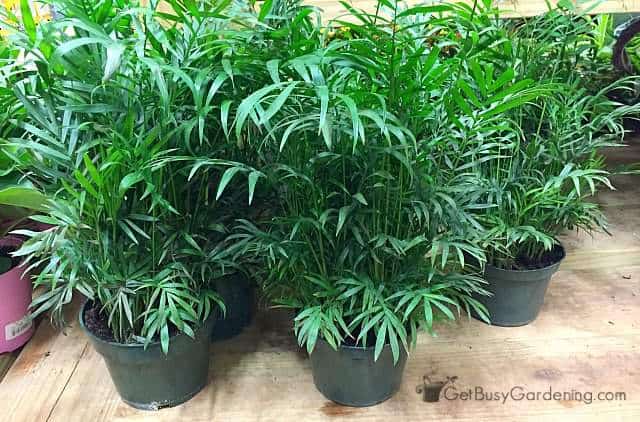
Light
Palm plants can easily adapt to low light conditions indoors. Most of them need bright, indirect light, and their leaves can burn in the direct sun.
They won’t survive in complete darkness though, so if there’s no sunlight in the room, you’ll definitely need to add a grow light.
If you put your palm plant outside during the summer, make sure to keep it in the shade so it doesn’t get sunburn.
Potting Soil
When it comes to the type of soil to use, palm plants aren’t super picky. But the best potting medium for them is a loose, porous mix, such as a combo of peat moss, leaf mold, and shredded bark.
You can also buy a fast draining mix that’s specifically made for them. Otherwise they will do just fine in a general purpose one.
If you tend to forget to water your plants, then you can add some peat moss and/or vermiculite into the soil to help it retain moisture longer.

Fertilizer
While they don’t really need to be fertilized, indoor palm plants will benefit from being fed as a part of your regular care routine.
However, they are very sensitive to chemical fertilizers, which can cause brown tips and margins, or easily burn the roots. So it’s best to use an organic option. My favorites are Jobe’s, Espoma, and Dr. Earth.
Whatever type you decide to use, be sure to only feed your plants during the spring and summer, and stop during the fall and winter to give them a rest.

Pest Control Tips
Spider mites are the most common pest that attack indoor palm plants. Keep the humidity level high around the foliage to fend them off. Houseplant scale and mealy bugs can also become a problem sometimes.
If you find any bugs, begin treating them immediately to prevent them from spreading. I recommend using organic neem oil, which is a natural pesticide.
Insecticidal soap also works well, or you can make your own by mixing 1 teaspoon of mild liquid soap with 1 liter of water.
Related Post: How To Get Rid Of Houseplant Bugs
Pruning
You can regularly trim back your indoor palm plants to keep them looking nice, or to maintain their size and shape. Spring is the best time to do maintenance pruning or to remove long, leggy stems.
It’s common for the lower leaves to turn yellow or brown with age, and you can cut off those fronds anytime of the year using regular pruning shears.
Brown tips and leaf edges are also very common. To trim those off, use a sharp pair of bonsai shears or micro-tip snips.
Troubleshooting Common Problems
It’s usually pretty easy to care for palm plants indoors. But sometimes your plant will start to have problems, and you’re not sure why. Below are the most common issues you might run into, with my tips for how to fix them:
Leaves Turning Brown Or Yellow
It’s normal for the lower, oldest fronds to turn yellow, then brown, and eventually die. So you can just prune those off as part of your regular maintenance routine.
However, if the newer, top leaves are turning brown and dying, then it’s usually caused by improper watering (too much or too little), bugs, or lack of humidity.
Let the soil dry 1-2″ deep before watering again, and check your plant for any signs of bugs. If it’s very dry in your home, try running a humidifier in the room or mist the foliage.
Brown Tips & Margins
One of the most common problems that indoor palm plants have is brown leaf margins and tips. This is usually caused by lack of water, dry air, chemical fertilizers, or pests.
Check to make sure you’re watering enough, and inspect the leaves for bugs. Use organic fertilizer rather than chemicals, and try to increase the humidity level around the plant.
For some species, brown tips and margins are just a normal part of their life cycle, so it’s not always something you can fix. If they bother you, simply trim them off to keep your plant looking its best.
Indoor Palm Tree Is Dying
There are several things that can cause indoor palm plants to die. The most common one is overwatering, but it could also be a lack of humidity, or inadequate lighting.
The soil should dry slightly between waterings, and never be completely bone dry or soggy.
Ensure your plant gets bright, indirect sunlight, and increase the humidity level if it has brown tips.
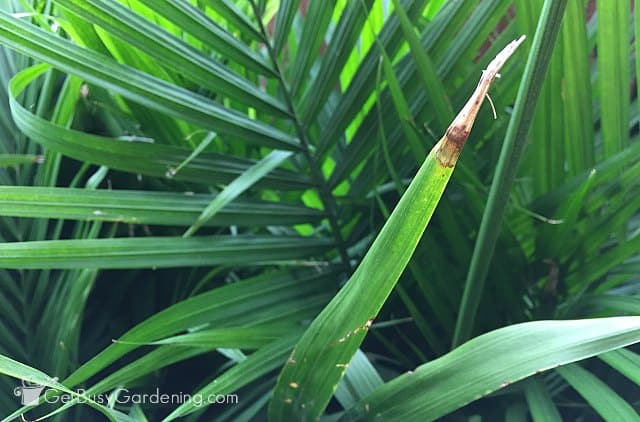
Indoor palm trees and plants are very low maintenance, and will thrive for years when you give them the proper care. Follow the tips in this guide for the best success.
If you want to learn all there is to know about maintaining healthy indoor plants, then you need my Houseplant Care eBook. It will show you everything you need to know about how to keep every plant in your home thriving. Download your copy now!
Share your indoor palm plant care tips and advice in the comments below.


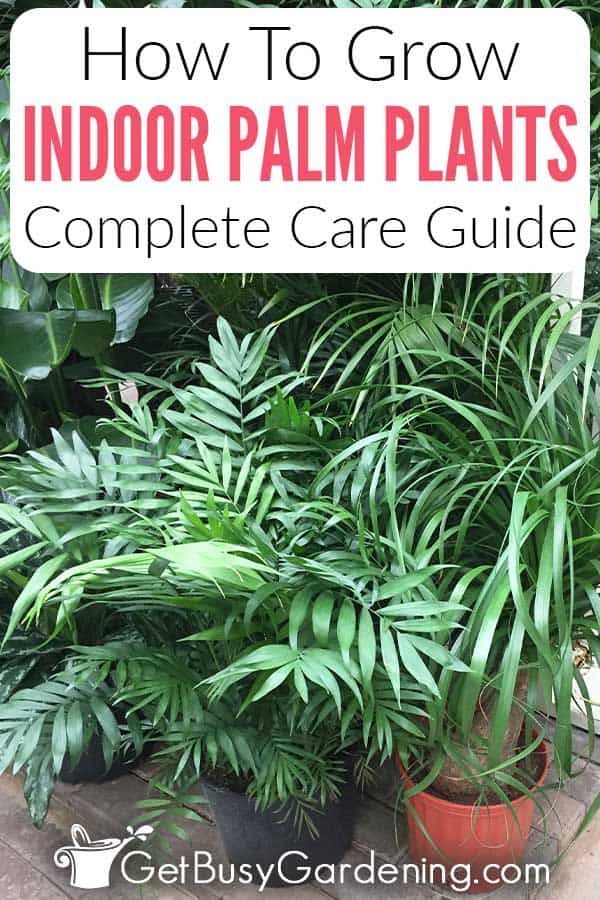
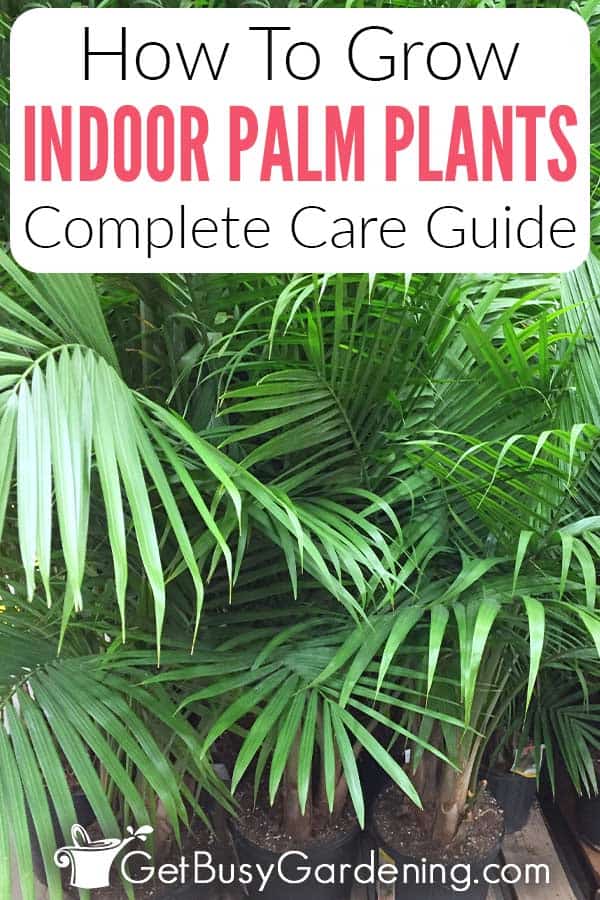
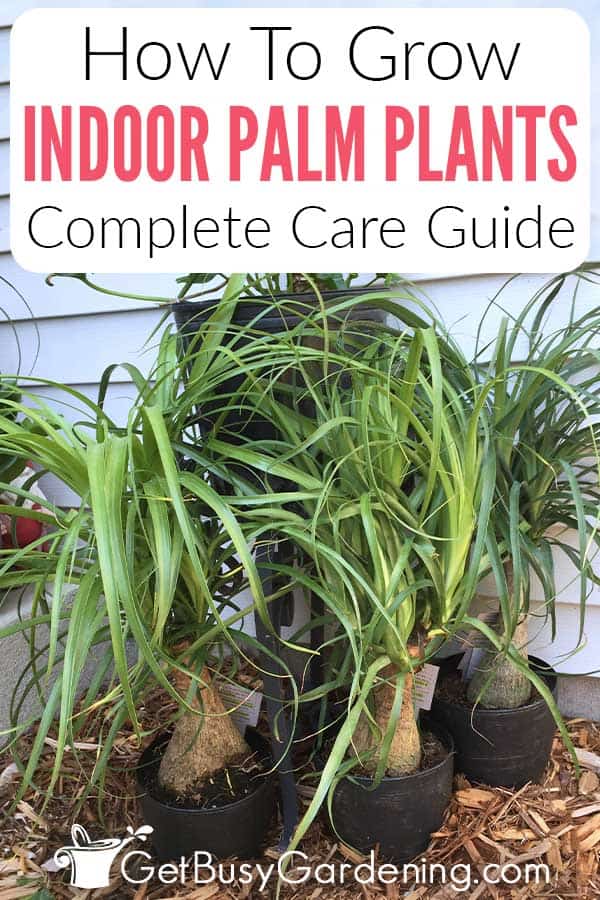
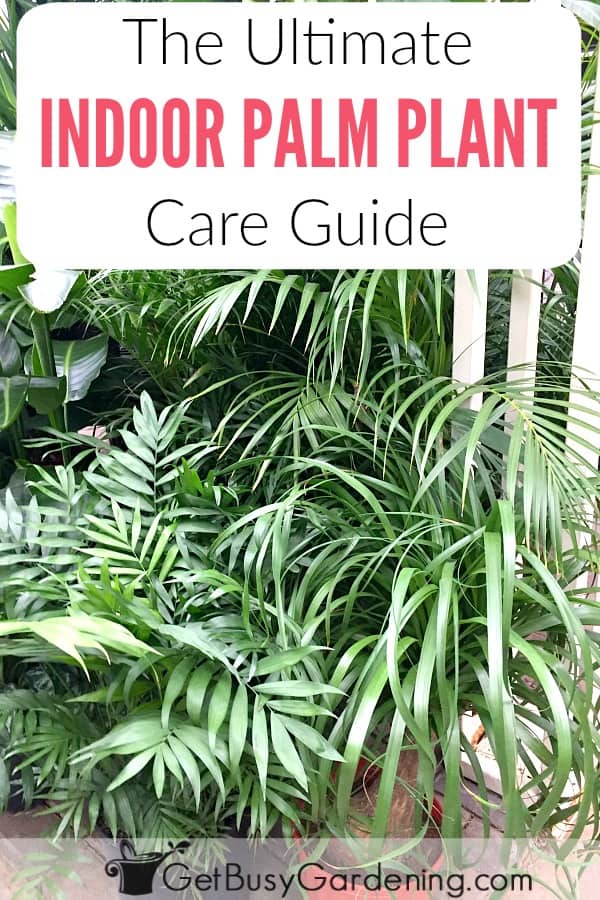
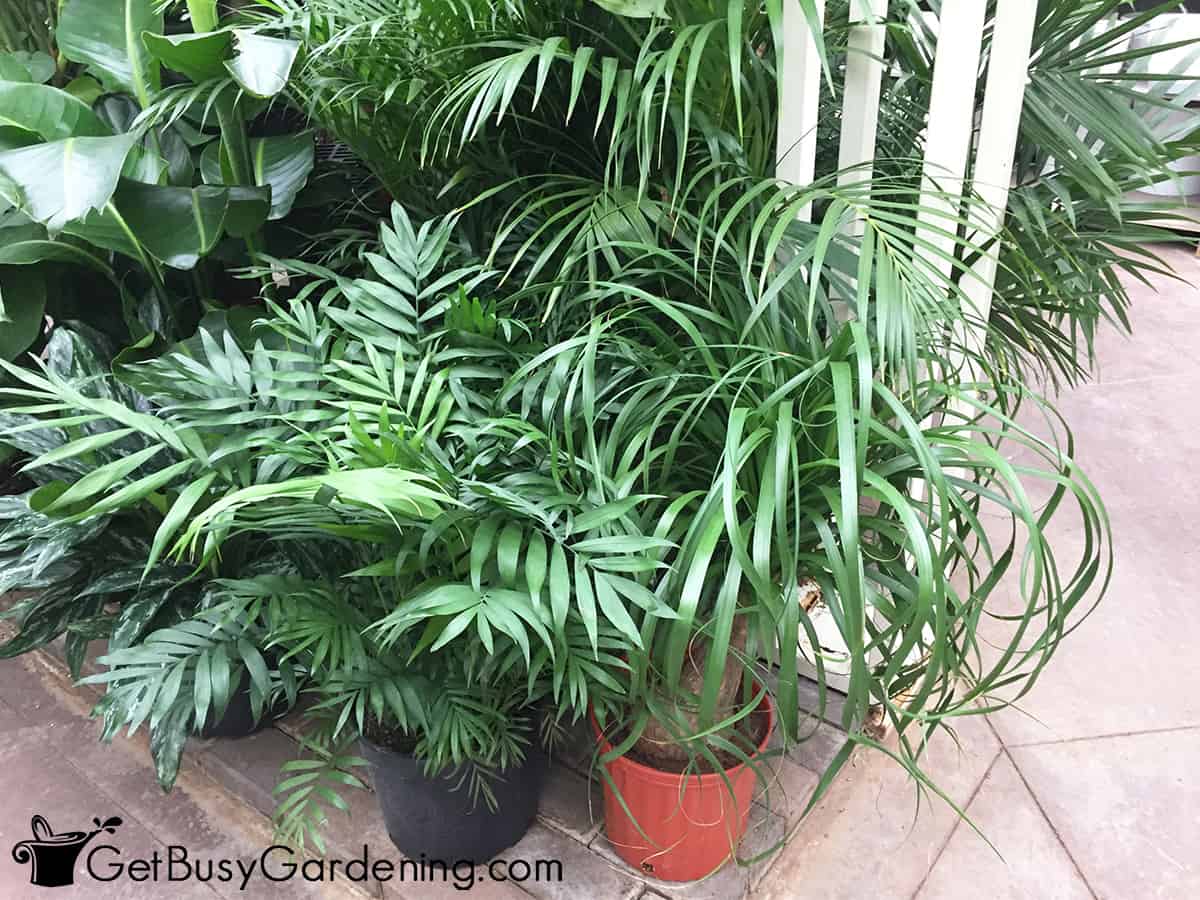



salvador says
hi Amy! I have my palm for months now and slowly deteriorating which makes me sad. I have been checking the soil moisture religiously and keeping it moist Is and has always been my approach. I have re potted it too, thinking that it maybe needed more space and/or new soil. so far, the remaining strand still standing but Im afraid it will have the same end result. I notice the soil too tends to dry up easily. need your opinion on this as they kept me company during quarantine and been praying for them to live long. appreciate your time on this. all the best!!!
Amy Andrychowicz says
It’s hard to help diagnose the problem with your palm plant without knowing the symptoms. You mentioned that you always make sure to keep the soil moist, so it makes me wonder if you’re overdoing it a bit. The soil should dry slightly between waterings, but never stay wet or dry out completely. Stick your finger at least 1″ into the soil to see how wet it is. Overwatering causes root rot, and it can be difficult to save a plant once it gets past a certain point. I would NOT recommend repotting it again, that is a huge stress on plants, and could end up killing it. I would just leave it alone, and monitor the moisture level to make sure it’s not too wet or drying out. Also, don’t give it any fertilizer until it recovers. Hopefully this helps.
Fred says
I just bought a new palm and have put it in a nice large pot with the soil that the nursery recommended. The pot has a drainage hole but nothing’s coming out of the bottom and some of the leaves are starting to turn yellow. It’s out of direct sunlight and was looking really healthy when I bought it! Is there any reason why it might not be draining and is there anything I can do to help it?
Amy Andrychowicz says
If your palm plant is really small in comparison to the pot, then you may have chosen a container that is too large. When repotting, it’s best to only go one size up (so, for example, from an 8″ up to a 10″ pot). If there’s tons of dirt in the pot, and not a lot of roots, then it can become compacted and hold too much water – leading to poor drainage and overwatering. You could try digging some of the soil out around the edges of the pot, and mixing in extra perlite or course sand to improve drainage. That should help.
EYVONNE NEWILL says
Ive3had my palm for years. This year one of the trunks started to shrivel up and the leavea came off. The reat of the plant is fine – i don’t know if I should cut it off and leave the raw part of the trunk or leave it alone??? I am afraid that its going to kill off the rest of my plant….
Amy Andrychowicz says
Yes, you can prune the dead leaves off of your palm plant, that won’t hurt it. Make sure you aren’t overwatering. The soil should never be very wet or soggy, or the roots will start to rot.
Ann Hemme says
We bought a large palm and split it into two pots. They both had fronds that died but now there are new shoots. The new shoots are not opening and it has been months. What do they need to be encouraged to open?
Amy Andrychowicz says
I would make sure that your palm plants are getting enough light, and also start fertilizing them.
Molly says
My palm used to be lively looking and the fronds were tall, now they all droop. What am I doing wrong?
Amy Andrychowicz says
Oh no, sorry to hear your palm plant is not doing well. It sounds to me like you are either over or under watering it. Most of the time, droopy fronds are from overwatering. Check the soil by sticking your finger one inch deep. If it feels wet, then let it dry out a bit more between waterings. If it’s dry, then water it more often. The most important thing to remember is to always check the soil before adding more water, and never do it automatically on a set schedule.
jen says
Hello Amy, how are you? I have had my palm tree for 40 years and we had to repot it 3 times due to its size as its massive and took over a whole room. I just had to trim it down as I had to take it out of the room where its been for many years as we turned it into a bedroom for my dad. Yesterday I watered it as usual and I noticed the bottom was filling up with water which overflowed and continues to leak. We cleaned it up. I thought that was it and this morning I woke up to see that water was all over the floor. I have never had this happen. What is happening? my husband will keep on eye on it today for further leaking.
Amy Andrychowicz says
Wow, your 40 year old palm tree sounds amazing! Sorry to hear about the water leak. It sounds to me like you may be overwatering it. Since you moved it into a different room, it may not require as much water as it did before. Moving plants changes their environment, and the conditions may be much different in the new room. They can also go into a bit of shock when they’re moved, which may also explain why it may not be needing as much water right now. It’s best to always check the soil before adding more water. You never want it to be saturated. Just give your palm plant time to adjust to its new home, and check the soil to see when it needs to be watered again. Hope this helps, and good luck!
Kristine says
My palm has powdery white, rice shaped clumps on it that seem to exist even within the new growth. A nursery doesn’t know what it is bit said it’s not scale or any insect. It used to be accompanied by an oily looking residue. What is this and what can I do about it?
Amy Andrychowicz says
Oh no, sorry to hear your palm plant is having problems! Hummm, I know they said it’s not any type of insect, but it sure sounds like mealybugs to me. Take a look at the pictures on this post to see if this looks like what you see… How To Get Rid Of Mealybugs On Your Houseplants, For Good!
Otherwise, my guess is that it’s some kind of a fungus or mildew. But normally, those aren’t rice shaped clumps, they would look more like a thin powder covering the leaves.
Janet says
Hi Amy! I have an indoor palm that I bought almost 40 years ago. It almost died about a decade ago but I was able to revive it! But now the cutting off of old fronds has left a mass of brown frond stubs around the stem. And I’m also worried it might be too shallow. How would I know?? Also can I tie the fronds together to make it more condensed and upright? It is so wide it takes up too much space!
Amy Andrychowicz says
I’m not exactly sure what you mean when you say you’re concerned that your palm plant might be too shallow. Are you thinking it may be pot-bound because it hasn’t been repotted in a while? If so, then telltale signs to look for are roots growing out of the drainage holes or on top of the soil, it won’t hold moisture very long, and/or the pot looks like it’s about to bust. Yes, you can tie back the fronds to keep them more compact, just be sure to tie them loosley. Good luck!
Masha Gerr says
Hello! I have had my palm for a while now, and it was doing great. All of a sudden the largest, freshest, healthiest fronds have begun to turn yellow, and then dry up. I have tried watering, not watering, fertilizing, and even adding a humidifier. At this point, I really don’t know what to do. Maybe the pot is too small? Please help!
Amy Andrychowicz says
When palm fronds turn yellow and/or brown, it’s almost always due to improper watering. Stick your finger at least one inch down into the soil to see if it feels wet or dry. Palms should never be allowed to dry out completely, they like consistently moist (but never soggy) soil. It’s best to allow the top inch of soil to dry out between waterings. Then give it a good drink of water, and allow the excess to drain completely from the pot. Be sure to dump it out right away, never allow your palm plant to sit in water. Check it weekly, and water it again once the top inch of soil feels dry.
Unfortunately, the discolored fronds will never recover, so you can just prune them off to clean it up if you want. Some types of palm plants are very slow to recover, so be patient. Also, whatever you do, don’t repot it to try to save it. Some palm plants hate being repotted, and doing it while the plant is sick could be fatal. Good luck!
Lisa says
Hello, my indoor 10 inch palm has stalks with seeds pods on them. Should I cut the off at the base of the stalk? They’ve been on there for months and my plant is starting to yellow so I’m afraid they are taking nutrients away from the plant. Help please! Thanks so much! Lisa
Amy Andrychowicz says
Yes, you can prune off the stalks on your palm plant all the way down to the base.
Samantha says
Hi! I’m not sure if this question has already been asked but I recently purchased a Bungalow palm and I do believe I’ve overwatered it..
Do you have any advice as to what I should do?
Amy Andrychowicz says
Oh no! Definitely allow the soil to dry out before watering your palm plant again. Stick your finger one inch into the soil, and don’t water it until it no longer feels damp. If the soil is super soggy, then you could try sliding the plant out of the pot in order for it to dry out faster.
Robert Keller says
The more I read that I need to use stuff labeled “organic” the more skeptical I become. Is there independent scientific evidence for this, or are we buying something because it has a catch phrase attached to it. Makes you feel like you really love your plants or are we just getting ripped off, again! Are plants like cats that will turn up their nose at anything less that “organic” People had houseplants growing happily away before “organic” became a marketing tool. Should I use fish fertilizer on my houseplants, it’s organic?
Amy Andrychowicz says
Whether you choose to use organic products or not is certainly your choice.
Sue says
I repotted my majesty palm about a month after purchasing it at a retail store -not a nursery. It seemed very healthy and full. It looked as if it was outgrowing the original pot so I repotted it about 2 months ago. Since then and at different times one “stalk” starts to turn brown on its leaves and then continues to brown until all of the leaves are brown. I have cut the “stalks” off each time. Now another one is starting to turn brown on its leaves. I think I am watering it correctly, according to your directions, and it has the proper light, again, according to your directions. It does not have any pests evident. What could be wrong? Thanks, in advance, for your answer.
Amy Andrychowicz says
It could be that your majesty palm suffered some shock after being repotted, and is slow to recover. But, the most common cause of majesty palm fronds (stalks) turning brown like you describe is improper watering. Some palm plants are more finicky than others when it comes to watering, and it can take some time to figure out the perfect balance. If you repotted it into a much larger pot than the original, it’s very easy to accidentally over or underwater a plant.
Stick your finger at least one inch into the soil to check the moisture level (or get a soil moisture gauge to make it easier). If the soil feels dry, then it’s not getting enough water. If the soil feels pretty wet, then let it dry a bit more between waterings. Never allow the soil to dry out completely for a majesty palm though. If you’re certain your watering routine is spot on, then I would give it a little more time to recover from being repotted. I would also hold off on fertilizing it until it has recovered. Good luck!
Elise says
hi, i have a Bangalow Palm, indoors. its in a part shade/part sun and isnt over watered. its outer leaves are starting to turn dry, crunchy and brown. could my heating cause this? the temperature is at about 21 degrees celcius.
Amy Andrychowicz says
Yes, heating a home sucks the humidity out of the air, and makes it very dry. One of the most common causes of brown tips on palm plants is lack of humidity. So I would recommend putting a humidifier in the room near your palm plant, or misting the plant on a regular basis.
Karen says
I have a plan that is secreting a sticky substance. What is it and how do I get rid of it?
Amy Andrychowicz says
When a plant is sticky like that, it may be a sign of a pest infestation. The likely culprits are either mealybugs or houseplant scale. Take a close look at the plant, and look for either white cotton (mealybugs) or brown bumps (scale) on the leaf joints and veins.
Al DeJong says
My palm is about 20 years old now and just over 6 feet tall. The problem is that the only foliage is on the top 2.5 feet at the top so basically I have a long skinny “trunk” with new, leaves on the top. As it’s grown, the lower fronds dry up, turn brown and die. It’s looking like the end is near but before I give up and start with a whole new plant, can the top 3rd be removed and rerooted? I realize now having read your wisdom I’ve probably overwatered. By the way, I’ve also experienced the tips turning brown if they touch the walls…just an observation. Thanks for listening!
Amy Andrychowicz says
Oh no, sorry to hear that your palm plant is struggling! The answer to your question depends on the type of palm plant you have (sorry I can’t give you a straight answer!). The way you describe it as having a tall skinny trunk, I wonder if you have a dieffenbachia, or maybe a dracaena of some kind, rather than a palm. If that’s the case, then yes, you could top your plant and root the cutting. However, that won’t work with true palm plants. So you may want to see if you can figure out what type of plant you have first. Otherwise, you could sure try experimenting with it. 🙂